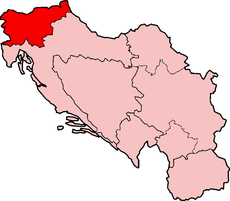- Socialist Republic of Slovenia
-
Socialistična republika Slovenija
Socialist Republic of SloveniaA federal unit of the
Socialist Federal Republic of Yugoslavia← 
←
1944 — 1990  →
→

Flag Coat of arms 
Capital Ljubljana Official language Slovene (Italian and Hungarian co-official in certain areas) Established
In the SFRY:
- Since
- Until19 February 1944
31 January 1946
8 March 1990Area
- Total
- WaterRanked 5th in the SFRY
20,246 km²
0.6%Population
- Total
- DensityRanked 5th in the SFRY
1,913,355
94.5/km²Currency Yugoslav dinar (dinar) Time zone UTC + 1 History of Slovenia 
This article is part of a seriesNoricum/Pannonia Slavic settlement of the Eastern Alps Samo's Realm Carantania Carniola Holy Roman Empire March of Carniola Windic March Illyrian Provinces Kingdom of Illyria Duchy of Carniola Drava Banovina Province of Ljubljana Socialist Republic of Slovenia Republic of Slovenia
Slovenia Portal
The Socialist Republic of Slovenia (Slovene: Socialistična republika Slovenija) was a socialist state that was a constituent country of the Socialist Federal Republic of Yugoslavia from 1943 until 1990. In 1990, while the country was still a part of the Yugoslav federation, the League of Communists of Slovenia allowed for the establishment of other political parties, which led to the democratization of the country.[1] Prior to 1963, the official name was the People's Republic of Slovenia (Ljudska republika Slovenija). On 8 March 1990, the Socialist Republic of Slovenia removed the prefix "Socialist" from its name, becoming the Republic of Slovenia, though remaining a constituent state of the Socialist Federal Republic of Yugoslavia until 25 June 1991, when it enacted the laws resulting in independence.
Towards secession
In March 1990, the Assembly of the Socialist Republic of Slovenia approved a number of constitutional changes that enabled a democratic transition. The socialist infrastructure was largely dissolved and open democratic elections were held in April of the same year. The parliamentary elections were won by the opposition, known as the DEMOS coalition led by the dissident Jože Pučnik. At the same time, Milan Kučan, the former chairman of the League of Communists of Slovenia (ZKS), was elected President of the Republic. The democratically elected parliament nominated the Christian Democratic leader Lojze Peterle as Prime Minister, which effectively ended the 45-year long rule of the Communist Party. During this period, Slovenia retained its old flag and coat of arms, and most of the previous symbols as it awaited the creation of new symbols that would eventually come after independence. The old national anthem, Naprej zastava slave was however replaced by the Zdravljica already in March 1990.
On 23 December 1990, a referendum on independence was held in Slovenia, in which 92,3% of the voters (88.5% of the overall electorate) voted in favour of secession of Slovenia from Yugoslavia. On 25 June 1991, the acts about the Slovenian independence were passed by the Assembly. Following a short Ten-Day War, the military of Slovenia secured its independence; by the end of the year, its independence was recognized by the wider international community.
References
See also
- Ustava Socialistične republike Slovenije - constitution of SR Slovenia from 1974 (in Slovene)
Socialist republics and socialist autonomous provinces of the Socialist Federal Republic of Yugoslavia SR Bosnia and Herzegovina · SR Croatia · SR Macedonia · SR Montenegro · SR Serbia (SAP Kosovo · SAP Vojvodina) · SR Slovenia
 Slovenia topics
Slovenia topicsHistory Timeline · Noricum/Pannonia · Slavic settlement of the Eastern Alps · Samo's Realm · Carantania · March of Carniola · Windic March · Illyrian Provinces · Kingdom of Illyria · Duchy of Carniola · Drava Banovina · Socialist Republic of SloveniaPolitics President · Prime Minister · Parliament · National Council · National Assembly · Court of Audit · Political parties · Elections · Constitution · Constitutional Court · Law · Judiciary of Slovenia · Foreign relations · Human rights (LGBT rights)Geography Statistical regions · Municipalities · Cities · Conservation · Districts and places · Fauna · Flora · Islands · Lakes · Mountains · Parks · Reservoirs · Rivers · Waterways · Urban planningEconomy History · Taxation · Ministry of the Economy · Companies · Banks · Bank of Slovenia · Ljubljana Stock Exchange · International rankingsDemographics Slovenes (list) · Slovene language · Education · Hungarians · Italians · Croats · Serbs · Macedonians · Roma in Slovenia · Jews in Slovenia · The Erased · Religion · Human rights · Social issuesCulture Transport Roads · Ljubljana Jože Pučnik Airport · Adria Airways · Buses · Driving · Rail · Aviation · Port of KoperMedia Radio · Magazines · Newspapers · Television · Media companies · Slovenian Press Agency · Internet domainSymbols Other topics Categories:- 1944 establishments
- 1990 disestablishments
- Second Yugoslavia
- Subdivisions of Yugoslavia
- Former Slavic countries
- States and territories established in 1944
- Political history of Slovenia
- Yugoslavia stubs
- Slovenia stubs
Wikimedia Foundation. 2010.
